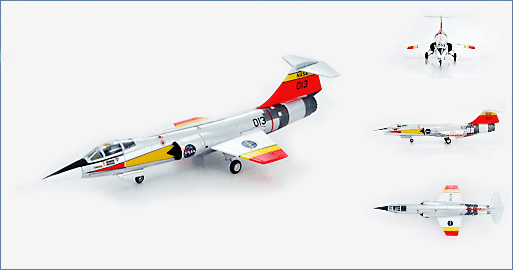Air Power Series>1:72 die-cast display model>F-104>HA1010
F-104N ,NASA Dryden Flt Research Ctr, 1966

General Background
The F-104 Starfighter was a revolutionary design with short razor-sharp wings. It was the first aircraft to be able to maintain Mach 2 not just in short bursts. The Starfighter shattered speed and rate of climb records that still are impressive today. This extremely high speed earned the plane the nickname "The Missile With A Man In It". Because of financial considerations 15 or more countries purchased the F-104. The Starfighter flew with the USAF in 1958 and the last airplane was decommissioned in Italy in 2004.
The Aircraft
In 1963 Lockheed delivered three purpose-built single seat F-104G Starfighters to NASA and re-designated them F-104N. Tail numbers were 011, 012 and 013. On June 8, 1966 the second North American XB-70A Valkyrie was on a public advertising photo shoot with 013 as chase plane. Speculation is 013 was flipped over by the vortices of the massive XB-70A and sheered off both Valkyrie vertical stabilizers. The F104N immediately burst into flames killing the test pilot. The Valkyrie also crashed killing its co-pilot.
Specifications :
| First Flight: | (XF-104) February 7, 1954 |
| Crew: | 1 pilot |
| Dimensions | |
| Height: | 13.50 ft (4.11 m) |
| Wingspan: | 21.92 ft (6.68 m) |
| Wing Area: | 196.1 ft2 (18.22 m2) |
| Length: | 54.75 ft (16.69 m) |
| Weight | |
| These aircraft were stripped of any military equipment in an effort to reduce weight | |
| Empty: | 14,082 lb (6,387 kg) |
| Max Takeoff: | 28,779 lb (13,054 kg) |
| Fuel Capacity: | Internal: 5,822 lb (2,641 kg) / External: 5,538 lb (2,512 kg) |
| Max Payload: | 4,310 lb (1,995 kg) |
| Propulsion | |
| Power plant: | 1 X General Electric J79-19 turbojet |
| Thrust: | 10,000 lb (44.5 kN) / 15,800 lb (70.28 kN) with afterburner |
| Performance | |
| Max Level Speed: | at altitude - 1,450 mph (2,335 km/h) at 36,000 ft (10,975 m), Mach 2.2 / at sea level - Mach 1.2 |
| Initial Climb Rate: | 4356 Kg50,000 ft (15,239 m) / min |
| Service Ceiling: | 58,000 ft (17,680 m) / 90,000 ft (27,430 m) zoom ceiling |
| Range: | typical - 260 nm (480 km) with max payload / ferry - 1,576 nm (2,920 km) |

